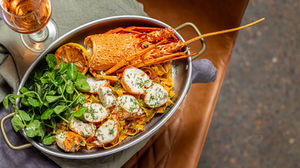Mixing it Up! The Art of Wine Blending
- Your Hunter Valley Magazine
- May 15, 2023
- 3 min read
Updated: Jun 14, 2023

From Cabernet Merlot and Shiraz, Tempranillo to Semillon Sauvignon Blanc and Vermentino Chenin Blanc, winemakers worldwide are becoming more adventurous and innovative with their blending techniques – creating wonderfully unique wine blends to entice the palate.
There's nothing new about blending wines of different varieties and vineyards at any stage of the winemaking process to create a finished wine. Blending wines has been practised for hundreds of years. It involves combining different wine varietals to create a rounded, flavoursome, and distinctive wine that is better than any of the wines separately on their own. Wine blends are popular because of their variety and profusion of flavour. However, most people are unaware that some of the world's most famous wines are blends.
At its most basic, winemakers blend wine made from different grapes to add more complexity to the flavour and texture of the wine, and many excellent wines, whether from Rioja, Bordeaux, Champagne, California, South Africa, or Australia, thrive on blending. Wines can be blended from multiple vintages of the same grape from the same vineyard; the same grape variety from a different region; two or more different grape varieties; or a combination of red and white grapes.
Some of the world's most renowned and greatest wines are made from a blend of grapes rather than a single varietal. These include the great Bordeaux and Rhône red blends of France and the Super Tuscan wines produced in Tuscany. It's also no secret that Penfold's Grange, Australia's most revered red wine, is a Shiraz Cabernet Sauvignon blend made with grapes from various South Australian wine regions. Another example is Champagne - this famous sparkling wine blend uses two or more grape varietals. However, the grape varieties of Pinot Noir, Chardonnay, and Pinot Meunier are the only ones allowed to be used in French Champagne.
Both reds and whites can be made from blends of varietals. Sometimes, they may even blend whites and reds to create the best possible combination of aromas and flavours. An example of this is blending the white Viognier variety with Shiraz – resulting in changes to the wine's final colour intensity and flavour. Perhaps the most famous white wine blend (at least in Australia) is Semillon Sauvignon Blanc. Sauvignon Blanc is more aromatic, juicy, and intensely flavoured, while Semillon adds a richer body, lower acidity and slightly savoury notes.
In Australia, Shiraz and Cabernet Sauvignon are two main red grape varieties that form the base of most red blends, and these are often blended to produce some of the greatest Australian wines ever made. These wines are complex and robust, with incredible ageing potential. Often the two varieties are taken from different regions to create extra levels of ripeness and layers of complexity.
Apart from Shiraz, Cabernet Sauvignon's main blending partner is usually Merlot, sometimes with lesser amounts of Cabernet Franc, Malbec, and Petit Verdot. Each of these blending partners brings something unique to Cabernet-based blends: Merlot adds richness, along with plum and violet characters; Cabernet Franc gives an aromatic lift and pepper, spice, and red berry characters; Malbec gives weight and dark fruit flavours while Petit Verdot delivers fragrance and rich dark fruit flavours.
Australian Shiraz makes a great red blending partner and provides numerous flavour and texture options that are multiplied exponentially by the variety of regions and blending possibilities. There are many Shiraz Grenache blends now available, and many feature Mourvèdre. These blending partners come together to make medium to full-bodied, spicy, complex wines that age well.
Sangiovese is another wine that is often blended with Shiraz. Shiraz's bold and robust nature enriches the savoury nature of the Sangiovese grape, coming together to create a rich and complex wine.
When it comes to food, red blends are incredibly versatile and pair with a variety of different dishes. From a selection of cheese and fruit or tapas to Mediterranean-style favourites like paella and rich plates of pasta, there are plenty of delicious food options to complement a red blend.
Australian blends taste better than ever, and winemakers are becoming more adventurous - producing modern Australian wine styles with intricate and exciting flavour combinations.











































































































